Related Research Articles
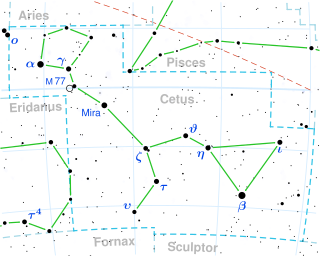
Mira, designation Omicron Ceti, is a red-giant star estimated to be 200–300 light-years from the Sun in the constellation Cetus.
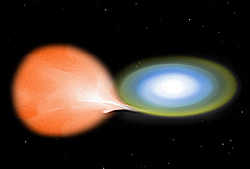
A nova is a transient astronomical event that causes the sudden appearance of a bright, apparently "new" star that slowly fades over weeks or months. Causes of the dramatic appearance of a nova vary, depending on the circumstances of the two progenitor stars. All observed novae involve white dwarfs in close binary systems. The main sub-classes of novae are classical novae, recurrent novae (RNe), and dwarf novae. They are all considered to be cataclysmic variable stars.

Stellar evolution is the process by which a star changes over the course of time. Depending on the mass of the star, its lifetime can range from a few million years for the most massive to trillions of years for the least massive, which is considerably longer than the current age of the universe. The table shows the lifetimes of stars as a function of their masses. All stars are formed from collapsing clouds of gas and dust, often called nebulae or molecular clouds. Over the course of millions of years, these protostars settle down into a state of equilibrium, becoming what is known as a main-sequence star.
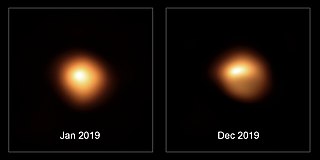
A variable star is a star whose brightness as seen from Earth changes with time. This variation may be caused by a change in emitted light or by something partly blocking the light, so variable stars are classified as either:

A giant star, also simply a giant, is a star with substantially larger radius and luminosity than a main-sequence star of the same surface temperature. They lie above the main sequence on the Hertzsprung–Russell diagram and correspond to luminosity classes II and III. The terms giant and dwarf were coined for stars of quite different luminosity despite similar temperature or spectral type by Ejnar Hertzsprung about 1905.

A Type Ia supernova is a type of supernova that occurs in binary systems in which one of the stars is a white dwarf. The other star can be anything from a giant star to an even smaller white dwarf.

A dwarf nova, or U Geminorum variable, is one of several types of cataclysmic variable star, consisting of a close binary star system in which one of the components is a white dwarf that accretes matter from its companion. Dwarf novae are dimmer and repeat more frequently than "classical" novae.

IK Pegasi is a binary star system in the constellation Pegasus. It is just luminous enough to be seen with the unaided eye, at a distance of about 154 light years from the Solar System.
Z Andromedae is a binary star system consisting of a red giant and a white dwarf. It is the prototype of a type of cataclysmic variable star known as symbiotic variable stars or simply Z Andromedae variables. The brightness of those stars vary over time, showing a quiescent, more stable phase and then an active one with a more pronounced variability and stronger brightening and/or dimming.

A symbiotic binary is a type of binary star system, often simply called a symbiotic star. They usually contain a white dwarf with a companion red giant. The cool giant star loses material via Roche lobe overflow or through its stellar wind, which flows onto the hot compact star, usually via an accretion disk.
A luminous supersoft X-ray source is an astronomical source that emits only low energy X-rays. Soft X-rays have energies in the 0.09 to 2.5 keV range, whereas hard X-rays are in the 1–20 keV range. SSSs emit few or no photons with energies above 1 keV, and most have effective temperature below 100 eV. This means that the radiation they emit is highly ionizing and is readily absorbed by the interstellar medium. Most SSSs within our own galaxy are hidden by interstellar absorption in the galactic disk. They are readily evident in external galaxies, with ~10 found in the Magellanic Clouds and at least 15 seen in M31.
A helium star is a class O or B star (blue), which has extraordinarily strong helium lines and weaker than normal hydrogen lines, indicating strong stellar winds and a mass loss of the outer envelope. Extreme helium stars (EHe) entirely lack hydrogen in their spectra. Pure helium stars lie on or near a helium main sequence, analogous to the main sequence formed by the more common hydrogen stars.

RR Telescopii is a symbiotic nova in the southern constellation Telescopium. It was recorded on photographic survey plates as a faint variable star between photographic magnitude (mpg) 9 to 16.6 from 1889 to 1944. In late 1944 the star began to brighten, increasing by about 7 magnitudes, from mpg ≈ 14 to brighter than 8. Brightening continued with a diminished rate of increase after early 1945, but the overall outburst was not noted until the star was seen at about 6.0, the threshold of naked eye brightness, in July 1948. At that time it was given the designation Nova Telescopii 1948. Since mid-1949 it has declined in brightness slowly, albeit accompanied by some remarkable changes in its spectrum, and as of August 2013 it had faded to visual magnitude around 12.

AG Pegasi is a symbiotic binary star in the constellation Pegasus. It is a close binary composed of a red giant and white dwarf, estimated to be around 2.5 and 0.6 times the mass of the Sun respectively. It is classified as a symbiotic nova; it has undergone one extremely slow nova outburst and a smaller outburst.
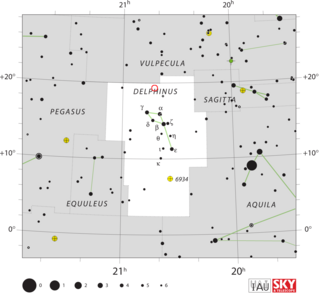
HR Delphini, also known as Nova Delphini 1967, was a nova which appeared in the constellation Delphinus in 1967. It was discovered by George Alcock at 22:35 UT on 8 July 1967, after searching the sky for over 800 hours with binoculars. At the time of discovery it had an apparent magnitude of 5.0. It reached a peak brightness of magnitude 3.5 on 13 December 1967, making it easily visible to the naked eye around that time. Pre-outburst photographs taken with the Samuel Oschin telescope showed it as a ~12th magnitude star which might have been variable.

BV Centauri is a cataclysmic variable binary star in the constellation Centaurus. It is a dwarf nova, and undergoes rapid increases in brightness that are recurrent with a mean period of 150 days. This period seems to have increased in the last few decades. During quiescence, its visual apparent magnitude is about 13, with variations of a few tenths of magnitude over an orbit due to differences in the star's visible surface area, brightening to a maximum magnitude of 10.7 during outbursts. From its luminosity, it is estimated that the system is about 500 parsecs (1,600 ly) away from Earth. A Gaia parallax of 2.81 mas has been measured, corresponding to about 360 pc.

V392 Persei, also known as Nova Persei 2018, is a bright nova in the constellation Perseus discovered on April 29, 2018. It was previously known as a dwarf nova.

DX Andromedae is a cataclysmic variable star in the constellation Andromeda. It has a typical apparent visual magnitude of 15.5 during the quiescent phase, but becomes brighter during outbursts recurring with a mean cycle length of 330 days, thus is classified as a dwarf nova of the SS Cygni type.
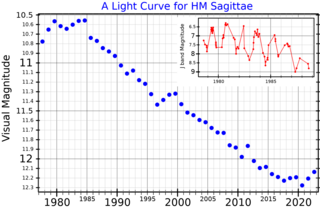
HM Sagittae is a dusty-type symbiotic nova in the northern constellation of Sagitta. It was discovered by O. D. Dokuchaeva and colleagues in 1975 when it increased in brightness by six magnitudes. The object displays an emission line spectrum similar to a planetary nebula and was detected in the radio band in 1977. Unlike a classical nova, the optical brightness of this system did not rapidly decrease with time, although it showed some variation. It displays activity in every band of the electromagnetic spectrum from X-ray to radio.

PU Vulpeculae is a very slowly evolving symbiotic nova in the northern constellation of Vulpecula, abbreviated PU Vul. It is too faint to be visible to the naked eye, reaching a maximum apparent visual magnitude of 8.7 following a minimum of 16.6. The system is located at a distance of approximately 17,000 light years from the Sun based on parallax measurements.
References
- 1 2 Bryan, Greg L.; Kwok, Sun (1991). "Energy distributions of symbiotic novae" (PDF). The Astrophysical Journal . 368: 252–260. Bibcode:1991ApJ...368..252B. doi:10.1086/169688. hdl: 10722/179631 . S2CID 121786223.
- ↑ Mikołajewska, J. (2007). "Symbiotic Stars: Continually Embarrassing Binaries". Baltic Astronomy. 16: 1–9. Bibcode:2007BaltA..16....1M.
- 1 2 MURSET U.; NUSSBAUMER H. (1994). "Temperatures and luminosities of symbiotic novae". Astronomy & Astrophysics . 282: 586–604. Bibcode:1994A&A...282..586M.
- ↑ Photometric and Spectroscopic Evolution of the Symbiotic Nova ... Archived 2016-03-03 at the Wayback Machine